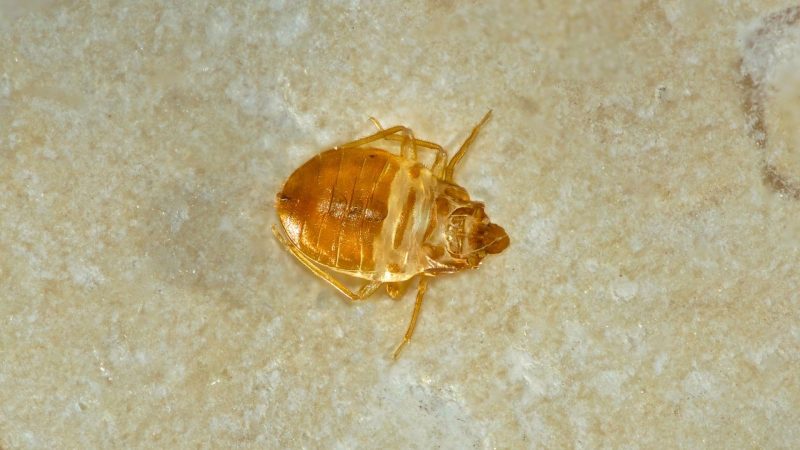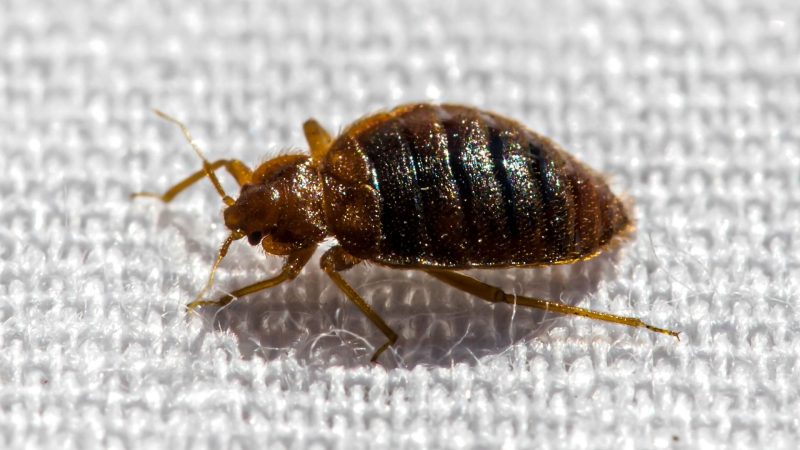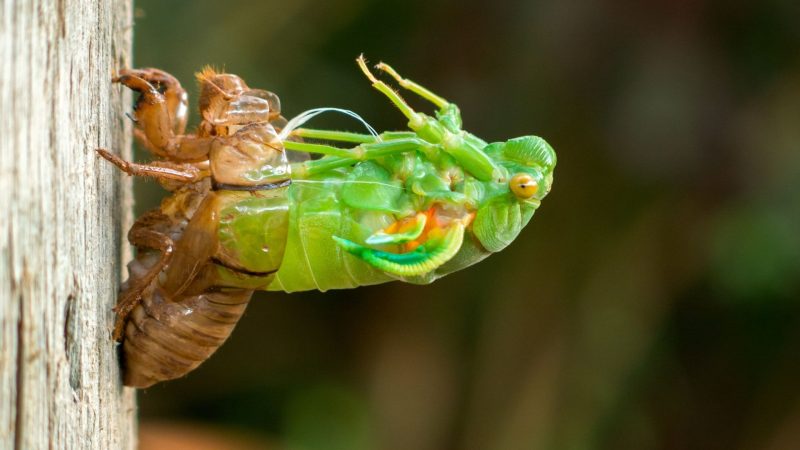If you woke up with some itchy, small, and flat bumps on your skin one morning, they are very likely to be bed bug bites. However, you still have to make sure that bed bugs really caused the bites. If you cannot find them, you may also see some bed bug shells, skin, and casings on your bed or under your mattress.
What are bed bug shells and casings? Bed bug shells and casings are basically the same, although they have different names. Just like other insects, bed bugs have an external skeleton called an exoskeleton to protect and support their bodies. This also serves as bed bugs’ skin, which they shed during the molting period.
Bed bugs undergo a molting period as part of their life cycle. Otherwise, they will not grow into adults and are very likely to die. Once they molt, expect to see some bed bug casings left behind. If you see lots of them, there could already be a bed bug infestation, and you should now act immediately.
What Do Bed Bug Shells and Casings Look Like?

At first glance, you may notice that bed bug shells and casings look like live or dead bed bugs. But once you look closer at them, you will realize that they are only empty shells. Molted skins have the same sizes and colors as bed bugs, depending on what life stage the bed bugs were in when they were molted.
To give you an idea, adult bed bugs are usually between ¼ in (5 mm) and 3/8 in (9 mm) long. They have flat, oval bodies and look like wood ticks. These wingless, blood-sucking insects are usually red-brown when hungry. But once they are already full, they will turn purple-red and become bigger and fatter.
On the other hand, young bed bugs (or newly hatched) called nymphs have the same body shape but are smaller. They are usually 1/16 in (1.6 mm) long and have a thinner exoskeleton. Most nymph bed bugs are also light yellow-white or colorless unless after feeding. So yes, they also suck blood and are also pests.
Bed bug shells or molted skin are also translucent, and you can see nothing inside them. Most of the time, a beg bug infestation occurs when bed bugs are still young. This is why you are likely to see lots of bed bug casings when you have multiple bed bug bites in your arms and body, especially in the morning.
Are Bed Bug Shells Hard or Soft?
Technically speaking, bed bug casings are hard shells, hard enough to serve as protective gears to their bodies against cold. This is why you may find it hard to crush bed bugs. Also, you will see their molted skin as a whole and not broken into pieces. The older the nymph is, the harder and bigger its shell is.
Do Bed Bug Shells Have Legs?
Bed bug casings have legs most of the time. However, some of them may be removed as time goes by. In fact, you can also see some perfectly shaped shells with antennae and other body parts. This is usually the scene when bed bugs are already infesting the area or when an infestation is only starting.
When and Why Do Bed Bugs Shed Their Skin?
As mentioned above, bed bugs shed their skin when they molt. The molting period is when bed bugs (and most insects) automatically remove their current skin and replace them with new ones. Just like cockroaches and lice, bed bugs undergo incomplete metamorphosis, which means they have three stages of the life cycle.
The three life stages of bed bugs are the egg, the nymph, and the adult stage. After mating, female bed bugs will lay 2 to 5 white, oval eggs every day. Each female will lay 200 – 250 eggs in her lifetime, and their egg size is 1/20 inch long. They usually lay eggs on small holes or rough surfaces near their human host.
How Often Do Bed Bugs Shed Skin?
Bed bug eggs usually hatch into nymphs within 10 to 15 days. Nymph bed bugs pass through five stages of molting. Therefore, they also shed their shells and casings five times. They need to suck blood at least once before proceeding to the next stage. This is why young bed bugs grow bigger, along with their shells.
Nymph bed bugs are about 1 mm long, which is the same as their shell size. After each molting stage, they grow around 0.5 mm bigger. But as they reach their fifth and final stage of molting, their size could be 3 times their size after their first molting. Below are the different sizes of bed bug shells and casings:
- Nymph bed bug eggshell size: 1 mm
- First nymph molting stage shell size: 1.5 mm
- Second nymph molting stage shell size: 2 mm
- Third nymph molting stage shell size: 2.5 mm
- Fourth nymph molting stage shell size: 3 mm
- Fifth nymph molting stage shell size: 4.5 mm
How Long Does It Take a Bed Bug to Shed Its Shell?
Each of the five molding stages of nymph bed bugs usually lasts for about a week. However, it may take longer if they have no host to feed on. On average, young bed bugs spend 35 – 48 days shedding their shells. But amazingly, they can still survive until 400 days without sucking blood.
Do Adult Bed Bugs Shed Their Skin?

Adult bed bugs will no longer shed their skin. Once nymphs turn into adults, their shells or casing will be hard enough, and they will stop growing even if they suck lots of blood. Nevertheless, their skin is flexible on the bottom part. It will expand to about twice its original size after they are satisfied with sucking blood.
When and Where Can I Usually Find Bed Bug Shells?
Bed bugs are generally nocturnal pests, which means they are most active at night when people are already sleeping. This is why you are most likely to see their empty shells in the morning. But in some cases, or when they are thirsty, bed bugs may search for hosts in the daytime, particularly in schools and offices.
You can usually find bed bug shells where the females hatch their eggs. Aside from the places mentioned earlier, you can also find them in seams, buttons, zippers, and folds on your mattress and behind your headboard. Amazingly, bed bugs can also squeeze their bodies in other hidden places such as the following:
- Furniture, especially under your chair, sofa, and couch.
- Edges of your carpet and upholstery.
- Under wall hangings and loose wallpaper.
- Inside your electronic appliances (including computers).
- Behind your wall clock and picture frames.
- Cabinet inside corners and drawer joints.
- Clothes that have not been used for a long time.
- Electrical receptacles, head of screws, and hinges.
As weird as it seems, bed bugs immediately hide once they are already satisfied. Nevertheless, they hide in warmer places, especially in colder months. And because these pesky pests are cold-blooded creatures, they prefer harboring on things that are made of fabric, paper, or wood rather than plastic or metal.
What Should I Do if I Found Bed Bug Casings?

Given their very small sizes, you can hardly see a single bed bug egg or nymph. However, you will likely see tons of them. And because the presence of bed bug casings lasts for more than a month, you have enough time to prepare on how to get rid of them. The key here is to start where you find lots of them.
Recent research shows that 85% of bed bugs and their shells or casings are found in or near the bed. Note that these bloodsuckers don’t go away on their own, and they multiply very quickly. This is why you should act at once if you find bed bug shells in your bedroom. Here are the important things you should do:
How to Remove Bed Bugs and Their Shells From Your Mattress?
- Vacuum your mattress and box springs. If you have a dust cover, remove it, and you may find more bed bugs underneath the box spring.
- Encase your mattress and box springs properly to avoid remaining bed bugs from escaping.
- Bring your vacuum outside your house and remove the vacuum bag.
- Wash your mattress and box springs with boiling water. Let them dry in direct sunlight at noontime. If there’s no sunlight, dry them for at least 30 minutes.
How to Remove Bed Bugs and Their Shells From Your Bed?
- If possible, remove your bed from your bedroom and clean it outside your house.
- If you will use an insecticide, spray it directly on the bed bugs. Otherwise, they may just crawl away and come back later.
- Spray on the bed frame and headboard. If the bed frame is made of wood, there’s a huge possibility that it also has bed bugs on its crevices. Use a flashlight or a magnifying glass.
- If the headboard is attached to the wall, remove it and spray on it and the wall surface. You may also find bed bugs behind it.
- If your bed is made of wood, it would be better if you dismantled it. As mentioned earlier, bed bugs prefer to hide in woods than in metals.
- Don’t forget to spray on screw heads and screw holes.
- If the bed bug infestation is worse, you may need a pest control professional.
What Other Insects Molt Their Casings?

Technically speaking, all insects that undergo incomplete metamorphosis shed their shells, skin, and casings. This process of shedding their exoskeletons is called ecdysis. The insects that molt or shed their casings belong to the orders Hemiptera, Odonata, and Orthoptera. Below are only some of them:
- Aphids
- Cicadas
- Crickets
- Cockroaches
- Damselfly
- Dragonfly
- Grasshoppers
- Leafhoppers
- Lice
- Locust
- Planthoppers
- Praying mantis
- Termites
Related: Baby Bed Bugs | Nymphs: Facts, Size and How to Identify
List of Sources
How to Identify a Bed Bug Infestation. Virginia Department of Agriculture and Consumer Services.
Hahn, J., Kells, S. (2021). Bed Bugs. University of Minnesota.
How to Find Bed Bugs. U.S. Environmental Protection Agency.
Brooks, S. (2021). Featured Creatures: Common Name: Bed Bug. University of Florida.
Insects in the City: Bed Bugs: Do-It-Yourself Control Options. Texas A&M AgriLife Research and Extension.
- How to Get Rid of Copperheads | Practical Guide - August 27, 2023
- How to Get Rid of Corn Snakes | What Makes Them Aggressive? - August 27, 2023
- How to Get Rid of Alligators | Safety Measures and Removal Methods - July 16, 2023
